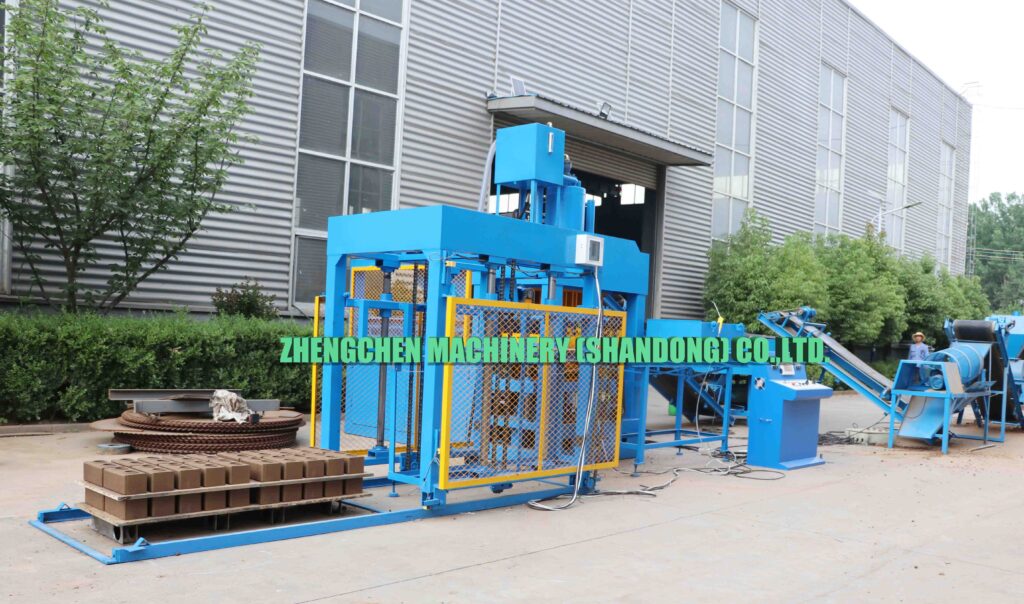An interlocking soil brick machine is a type of brick-making machine designed to produce bricks from a mixture of soil, cement, and water. The bricks produced by this machine are called interlocking soil bricks because they have a unique design that allows them to fit together like puzzle pieces without the need for mortar or any other binding material.
How an interlocking soil brick machine typically works?
Raw material preparation:
The process starts by gathering suitable soil and mixing it with cement and water to create a homogenous mixture. The proportion of soil, cement, and water can vary depending on the specific machine and the desired strength of the bricks.
1. Loading the machine:
The prepared soil-cement mixture is then loaded into the brick-making machine’s hopper or container.
2. Compression and molding:
The machine uses a hydraulic or mechanical system to compress the mixture into the desired brick shape. The compression is essential to create bricks that are sturdy and have the necessary strength.
3. Curing:
After the bricks are molded, they need to cure and gain strength. Curing can be done by keeping the bricks in a controlled environment with adequate moisture for a specific period.
What are the types of interlocking soil brick machine?
Interlocking soil brick machines come in various types and configurations, each catering to different production capacities and specific needs.
According to different classification principles, interlocking soil brick machines can be categorized into different types.
Classification based on degree of automation
Manual Interlocking Brick Machine:
This is the most basic type of interlocking soil brick machine and is operated manually. It requires human effort to load the raw material, operate the compression mechanism, and remove the molded bricks. Manual machines are suitable for small-scale production and are often used in areas with limited access to electricity or for community-based brick-making projects.
Semi-Automatic Interlocking Brick Machine:
Semi-automatic machines have some automated features to aid the brick-making process. They typically have a motorized or hydraulic system to assist with the compression of the soil-cement mixture. While some aspects of the process are automated, these machines still require manual intervention for material loading, brick removal, and other tasks.
Fully Automatic Interlocking Brick Machine:
Fully automatic machines are the most advanced and efficient type of interlocking soil brick machines. They are equipped with electric motors, sensors, and programmable controls to handle the entire brick-making process automatically. These machines can produce a large number of bricks with minimal human intervention, making them suitable for high-volume production.
Classification based on mobility
Mobile Interlocking Brick Machine:
Mobile machines are designed to be portable and can be easily moved from one location to another. They are especially useful for construction projects in remote areas where transporting bricks from distant sources might be challenging. Mobile interlocking brick machines come in various configurations, including manual, semi-automatic, and fully automatic types
Stationary interlocking brick machine
A Stationary Interlocking Brick Machine is a specific type of interlocking soil brick machine that is designed to remain fixed or stationary at a particular location during its operation. Unlike mobile interlocking brick machines that are portable and can be easily moved to different sites, the stationary machine is set up at a fixed location (typically in proximity to the source of raw materials (soil and cement) and where the bricks will be used in construction projects) and is intended to stay there for continuous brick production.
Classification based on molding technology
Physical Leverage Interlocking Brick Machine:
It refers to the mechanical advantage gained by using a lever or a system of levers to amplify force. This kind of brick machine also belongs to manual brick machine.
Hydraulic Interlocking Brick Machine:
Hydraulic machines use hydraulic pressure to compress the soil-cement mixture and mold the bricks. They offer higher compression force, which results in stronger and more durable bricks. Hydraulic interlocking brick machines are available in both semi-automatic and fully automatic versions.
Classification based on power source
Manual Interlocking Brick Machine:
Power Source: Human effort
Description: Manual interlocking brick machines are operated entirely by hand. The compression of the soil-cement mixture and the production of bricks require physical effort from the operator. These machines are simple, affordable, and suitable for small-scale or community-based brick-making projects.
Electric Interlocking Brick Machine:
Power Source: Electricity
Description: Electric interlocking brick machines are powered by an electric motor. The motor provides the energy needed for the compression mechanism and other automated functions, making the brick-making process easier and faster compared to manual machines.
Diesel Interlocking Brick Machine:
Power Source: Diesel engine
Description: Diesel interlocking brick machines are equipped with a diesel engine that drives the compression system and other moving parts. These machines are commonly used in areas with limited or unreliable electricity supply, as diesel engines provide a more reliable power source.
Interlocking soil bricks are becoming increasingly popular in various parts of the world, especially in regions where conventional building materials are expensive or scarce. The bricks are cost-effective, environmentally friendly, and easy to produce, making them suitable for sustainable construction practices.
The use of interlocking soil bricks also promotes better heat and sound insulation in buildings due to the natural properties of the materials used. Additionally, the interlocking design enhances the overall stability of the construction and allows for greater earthquake resistance.

